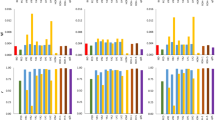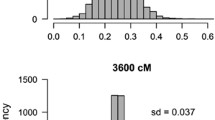Summary
In selected populations, families superior for the selected trait are likely to contribute more offspring to the next generation than inferior families and, as a consequence, the rate of inbreeding is likely to be higher in selected populations than in randomly mated populations of the same structure. Methods to predict rates of inbreeding in selected populations are discussed. The method of Burrows based on probabilities of coselection is reappraised in conjunction with the transition matrix method of Woolliams. The method of Latter based on variances and covariances of family size is also examined. These methods are one-generation approaches in the sense that they only account for selective advantage over a single generation, from parents to offspring. Two-generation methods are developed that account for selective advantage over two generations, from grandparent to grandoffspring as well as from parent to offspring. Predictions are compared to results from simulation. The best one-generation method was found to underpredict rates of inbreeding by 10–25%, and the two-generation methods were found to underpredict rates of inbreeding by 9–18%.
Similar content being viewed by others
References
Bulmer MG (1971) The effect of selection on genetic variability. Amer Nat 105:201–211
Burrows PM (1984a) Inbreeding under selection from unrelated families. Biometrics 40:357–366
Burrows PM (1984b) Inbreeding under selection from related families. Biometrics 40:895–906
Crow JF, Kimura M (1971) An introduction to population genetic theory. Harper and Row, New York, Evanston and London
Ewens WJ (1982) On the concept of effective population size. Theor Popul Biol 21:373–378
Gowe RSA, Robertson A, Latter BDH (1959) Environment and poultry breeding problems. 5. The design of poultry control strains. Poult Sci 38:462–471
Hill WG (1972) Effective population size of populations with overlapping generations. Theor Popul Biol 3:278–289
Hill WG (1979) A note on effective population size of populations with overlapping generations. Genetics 92:317–322
Hill WG (1985) Fixation probabilities of mutant genes with artificial selection. Genét Sél Evol 17:351–358
Latter BDH (1959) Genetic sampling in a random mating population of constant size and sex ratio. Aust J Biol Sci 12:500–505
Robertson A (1961) Inbreeding in artificial selection programmes. Genet Res Camb 2:189–194
Verrier E (1989) Prédiction de l'évolution de la variance genétique dans les populations animales d'effectif limité soumises à selection. PhD thesis, INA-Paris-Grignon, France
Verrier E, Colleau JJ, Foulley JL (1990) Predicting cumulated response to directional selection in finite panmictic populations. Theor Appl Genet 79:833–840
Woolliams JA (1989) Modifications to MOET nucleus breeding schemes to improve rates of genetic progress and decrease rates of inbreeding in dairy cattle. Anim Prod 49:1–14
Wray NR, Thompson R (1990) Prediction of rates of inbreeding in selected populations. Genet Res Camb 55:41–54
Wright S (1931) Evolution in Mendelian populations. Genetics 16:97–159
Author information
Authors and Affiliations
Additional information
Communicated by D. Van Vleck
Rights and permissions
About this article
Cite this article
Wray, N.R., Woolliams, J.A. & Thompson, R. Methods for predicting rates of inbreeding in selected populations. Theoret. Appl. Genetics 80, 503–512 (1990). https://doi.org/10.1007/BF00226752
Received:
Accepted:
Issue Date:
DOI: https://doi.org/10.1007/BF00226752




